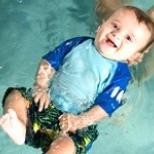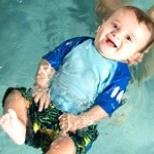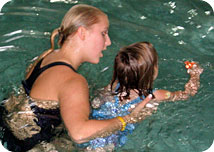
Infant/Toddler: Taking Care of Baby’s Teeth

Children's health doesn't stop at the pool. Here is some information to take care of one of Swimtastic's favorite aspects of our students: their smiles. Dental decay, or cavities, is the most prevalent childhood disease and can begin as soon as the first tooth starts to erupt. If decay isn’t treated it can destroy the tooth possibly leading to infection or even damage to the permanent tooth developing beyond it. Decay happens when the tooth is in contact with sugary liquids and foods. Every time the tooth comes into contact with sugar there is an acid attack on the tooth. The more often the tooth is attacked the weaker it becomes. When teeth are in constant contact with sugary liquids, such as sucking on a pacifier that has been dipped in honey or sugar, the teeth are under constant attacks and decay can happen much faster. Try not to clean baby’s pacifier with your own mouth as you could pass decay causing bacteria. Children also shouldn’t be allowed to constantly suck on a bottle or sippy cup with sugary drinks such as juice, soda, and even milk! Only put little ones to bed with bottles or cups if they have water in them instead.
Chronic gingivitis, which is a mild form of periodontal infection, is also common in children. Gingivitis can be painful and sometimes lead to worse infections in the mouth. This is caused by poor oral hygiene leading to plaque building up. Even before the first tooth erupts clean your baby’s gums with a wet washcloth or a clean gauze pad after feeding. When gums are sore as teeth begin to erupt around 6 months, gently massage the areas with a damp gauze pad, cool spoon, or clean finger. As the teeth erupt look at them periodically. If you see any white spots or stained areas you should make an appointment with your dentist.
of periodontal infection, is also common in children. Gingivitis can be painful and sometimes lead to worse infections in the mouth. This is caused by poor oral hygiene leading to plaque building up. Even before the first tooth erupts clean your baby’s gums with a wet washcloth or a clean gauze pad after feeding. When gums are sore as teeth begin to erupt around 6 months, gently massage the areas with a damp gauze pad, cool spoon, or clean finger. As the teeth erupt look at them periodically. If you see any white spots or stained areas you should make an appointment with your dentist.
An appointment should be scheduled with your dentist any time after the first tooth erupts up to their first birthday. This gives your dentist the opportunity to look at tooth and jaw development, check for decay, look for other tooth problems, and teach you how to clean your baby’s teeth and gums. Once the first tooth appears you can start brushing with a soft bristled child-sized toothbrush twice a day. If you are not sure if your child is getting enough fluoride to protect their teeth you can discuss this with your dentist or pediatrician. Use a smear or rice grain sized amount of fluoridated toothpaste to brush baby’s teeth until your child is about 3 years old. Primary teeth usually have spaces between them, which do not need to be flossed. Once teeth erupt that have a tight contact, those areas should be flossed. Children should still be supervised while brushing and flossing until they are about 8 years old.
Swimtastic offers a clinic designed specifically for families with infants and toddlers ages 6 months - 2 years old. If you have an interest in our Swim Baby or Swimtastic Swim Baby parent-child swim classes, this is the perfect way to get your child introduced to water safety!
Register today to get more information!




